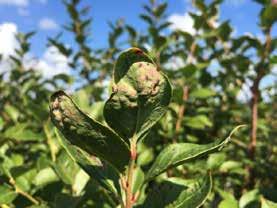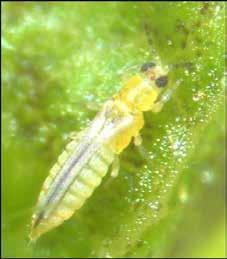
4 minute read
Craft Your Plan of Attack Against Chilli Thrips
Management and Control on Southern Highbush Blueberry
As late spring and early summer approach, it’s time to start thinking about managing chilli thrips. This has been reported as the most significant insect pest on blueberries in Florida, often taking repeated applications of different insecticides to achieve and maintain control.
Advertisement

Figure 1. Adult chilli thrips. Credit: B. Panthi, UF/IFAS
Description and Life Cycle
Chilli thrips adults are small (less than 1/16 inch in length) and ¾ size of flower thrips, with pale yellow bodies with dark fringed wings and dark brown incomplete stripes on the abdomen (Figure 1). The lifecycle of chilli thrips (i.e., egg to adult) is short and typically lasts about 18–20 days at 77–81°F, with four life stages: egg, larva, pupa and adult. Adult females can lay about 60 eggs in its lifetime, with eggs usually hatching in 5–8 days. Adults live for 20–25 days at 77°F. and typically only fly short distances, initially forming “hot spots” in the fields and then moving to adjacent plants as the amount and quality of the foliage decreases. Heavy infestations of chilli thrips may occur during prolonged hot and dry periods (June through September), although growers often report seeing them beginning in May.
Description and Life Cycle
Chilli thrips feed primarily on young blueberry foliage, usually beginning in late May or early June with the first post-pruning foliar flush. Injury symptoms first appear as bronzing along leaf veins and petioles, and gradually leaves start to curl and distort (Figure 2). Heavy infestations cause leaf defoliation with extensive curling of leaves.
Management and Control
The appearance of bronzing on new flush may be the first indication of the presence of chilli thrips in blueberry fields. However, at that point populations may already have already become established, so scouting for the presence of adults is essential. Scouting can be done by observing young leaves with a 10X hand lens, tapping young foliage onto a white sheet of paper or using white or yellow sticky cards. Chilli thrips tend to have clumped distribution when a population begins to assemble in a field, therefore, sufficient samples should be taken to accurately estimate its population in the field


Figure 2. Feeding injury caused by chilli thrips feeding on blueberry leaves. Credit: B. Panthi, O. Liburd, UF/IFAS
An integrated management plan to control chilli thrips includes cultural, biological, and chemical control tactics. Cultural control consists of eliminating host plants (including weeds) in or near production fields that support the growth and development of chilli thrips. Natural predators can also be part of an integrated management program. Natural enemies such as Orius insidiosus (minute pirate bug, which feeds on all life stages of thrips), Amblyseius swirskii (predatory mites), and Geocoris spp. (big-eyed bugs) have shown some potential to manage chilli thrips populations if integrated with other tactics.
Chemical insecticides are the primary means to manage chilli thrips populations in blueberry. Reduced-risk insecticides registered for controlling chilli thrips in blueberry are spinetoram (Delegate®), tolfenpyrad (Apta®), cyantraniliprole (Exirel®), acetamiprid (Assail®), and flupyradifurone (Sivanto®). Spinosad (Entrust®) can be used to manage this pest in organic blueberry production. In a recent field trial, tolfenpyrad and acetamiprid were the most effective of the insecticides evaluated measured by the number of thrips per leaf after treatment, and tolfenpyrad and flupyradifurone with Induce were most effective based on leaf bronzing ratings following treatment. In recent years some growers have reported decreased effectiveness of spinetoram for thrips management in Florida. A list of products registered for managing chilli thrips in Florida blueberries along with their active ingredients and insecticide classes is provided in Table 1. Be sure to follow all insecticide label instructions, including rotating appropriate products with different modes of action to help minimize the development of insecticide resistance.
This table lists registered pesticides that should be integrated with other pest-management methods. Additional information on integrated pest management methods can be requested from UF/IFAS Extension horticulture or agriculture Extension agents. A list of local UF/IFAS Extension county offices is available at https://ifas.ufl.edu/.
DR. OSCAR LIBURD, professor, UF/IFAS & DOUG PHILLIPS, Blueberry Extension Coordinator, UF/IFAS


